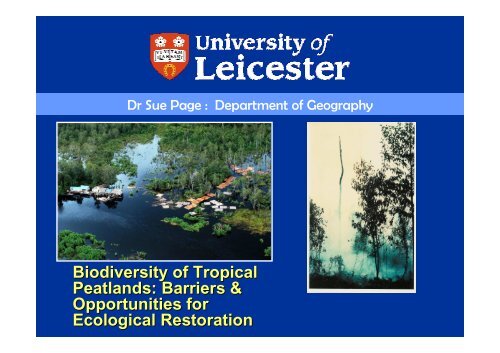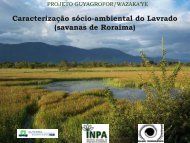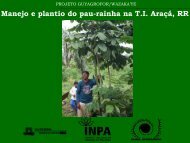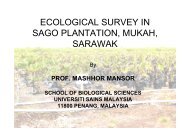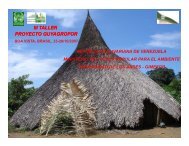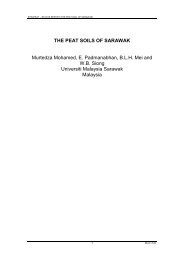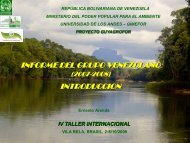Biodiversity of Tropical Peatlands: Barriers ... - SPLU.nl
Biodiversity of Tropical Peatlands: Barriers ... - SPLU.nl
Biodiversity of Tropical Peatlands: Barriers ... - SPLU.nl
Create successful ePaper yourself
Turn your PDF publications into a flip-book with our unique Google optimized e-Paper software.
Dr Sue Page : Department <strong>of</strong> Geography<br />
<strong>Biodiversity</strong> <strong>of</strong> <strong>Tropical</strong><br />
<strong>Peatlands</strong>: <strong>Barriers</strong> &<br />
Opportunities for<br />
Ecological Restoration
Natural Resource Functions <strong>of</strong><br />
<strong>Tropical</strong> <strong>Peatlands</strong><br />
Local -------- Regional -------- Global<br />
<br />
Maintenance <strong>of</strong> biodiversity<br />
Carbon storage<br />
Water management<br />
Source <strong>of</strong> timber & non-timber forest products<br />
Fish spawning & breeding grounds<br />
Palaeo-archive<br />
Etc.<br />
DEPARTMENT OF GEOGRAPHY
Function:<br />
Maintenance <strong>of</strong> <strong>Biodiversity</strong><br />
<br />
<br />
<br />
Understand the character <strong>of</strong> the natural<br />
ecosystem.<br />
Understand the floral and faunal diversity.<br />
Understand the ecosystem features that maintain<br />
biodiversity –<br />
energy flow<br />
nutrient cycling<br />
community dynamics<br />
DEPARTMENT OF GEOGRAPHY
Character <strong>of</strong> the natural system<br />
<br />
<br />
<strong>Tropical</strong> peatlands are unique<br />
ecosystems<br />
Acidic<br />
Nutrient-poor<br />
Waterlogged<br />
Thick organic soil<br />
Support specialised peat swamp<br />
forest plant and animal<br />
communities.<br />
DEPARTMENT OF GEOGRAPHY
Global<br />
<br />
<br />
<br />
~ 800 tree species recorded<br />
from the peat swamp forests<br />
<strong>of</strong> SE Asia.<br />
~ 71 families ~ 237 genera.<br />
Many display characteristic<br />
adaptations to the habitat,<br />
e.g. stilt roots,<br />
pneumatophores.<br />
Xylopia fusca<br />
DEPARTMENT OF GEOGRAPHY
Global<br />
<br />
In western Malesia, Borneo is the centre <strong>of</strong><br />
species richness for the tree flora <strong>of</strong> peat<br />
swamp forest.<br />
Borneo >380 spp.<br />
P. Malaysia >170 spp.<br />
DEPARTMENT OF GEOGRAPHY
Regional<br />
Peat swamp forest no. species<br />
Euphorbiaceae 50<br />
Myrtaceae 47<br />
Lauraceae 42<br />
Clusiaceae 36<br />
Rubiaceae 35<br />
Dipterocarpaceae* 32<br />
* most diverse family in lowland rain forest<br />
DEPARTMENT OF GEOGRAPHY
Regional<br />
Kalimantan<br />
tree sp / ha<br />
Lowland dipterocarp forest ~300-400<br />
Heath forest ~100-170<br />
Peat swamp forest ~ 75-120<br />
Sub-montane forest ~115<br />
Montane forest ~ 48<br />
Mangrove ~ 6-15<br />
DEPARTMENT OF GEOGRAPHY
Peat Swamp Endemics<br />
<br />
<br />
<br />
<br />
<br />
<br />
Archidendron clypearia<br />
Dactylocladus stenostachys<br />
Gonystylus bancanus*<br />
Horsfieldia crassifolia*<br />
Shorea belangeran*<br />
Shorea teysmanniana<br />
Gonystylus bancanus<br />
* On the CITES (IUCN) red list <strong>of</strong> endangered plant species.<br />
DEPARTMENT OF GEOGRAPHY
Regional Variation<br />
<br />
High regional floral variation.<br />
<br />
O<strong>nl</strong>y five tree species (from total ~800 spp.)<br />
recorded from psf across the whole west Malesian<br />
region:<br />
<br />
<br />
<br />
<br />
<br />
Baccaurea bracteata<br />
Campnosperma coriaceum<br />
Ilex cymosa<br />
Madhuca motleyana<br />
Stemonurus secundiflorus<br />
DEPARTMENT OF GEOGRAPHY
Greatest regional similarity :<br />
Peninsular Malaysia + Borneo<br />
Total no. tree species in common ~ 50<br />
Less similarity between psf tree flora <strong>of</strong><br />
other areas (Sumatra, Thailand)<br />
DEPARTMENT OF GEOGRAPHY
Regional variation - within Borneo<br />
<br />
<br />
<br />
<br />
O<strong>nl</strong>y three widespread tree species in the peat<br />
swamp forests <strong>of</strong> Borneo:<br />
Dactylocladus stenostachys<br />
Cratoxylum arborescens<br />
Koompassia malaccensis<br />
<br />
High levels <strong>of</strong> floral variation between psf in<br />
Sarawak, Brunei, W, C, S & E Kalimantan.<br />
DEPARTMENT OF GEOGRAPHY
Local: Phasic communities<br />
<br />
<br />
<br />
Anderson identified six phasic<br />
communities in the Sarawak peat swamps.<br />
Page et al. identified five communities in<br />
the Sebangau peatland, C. Kalimantan.<br />
O<strong>nl</strong>y 2 or 3 communities described from<br />
peat swamps <strong>of</strong> Sumatra/P.Malaysia<br />
DEPARTMENT OF GEOGRAPHY
Local : Phasic Communities<br />
<br />
Central Kalimantan:<br />
Riverine forest<br />
Marginal mixed swamp forest (MSF)<br />
Low pole forest (LPF)<br />
Very low pole forest (padang)<br />
Tall interior forest (TIF)<br />
Unique community<br />
dominated by<br />
Palaquium leiocarpum<br />
DEPARTMENT OF GEOGRAPHY
Local : Phasic Communities<br />
Neoscortechinia kingii MSF TIF<br />
Palaquium cochleariifolium MSF LPF<br />
P. ridleyi MSF<br />
Calophyllum hosei MSF<br />
Mesua sp. MSF<br />
Combretocarpus rotundatus MSF LPF<br />
Mezzettia parviflora MSF<br />
Szygium sp. LPF<br />
Tristaniopsis obovata LPF<br />
Shorea teysmanniana LPF TIF<br />
Palaquium leiocarpum TIF<br />
Stemonurus secundiflorus TIF<br />
Mezzettia parviflora TIF<br />
Floral & structural differences<br />
MSF – mixed swamp forest; LPF – low pole forest;<br />
TIF – tall interior forest<br />
DEPARTMENT OF GEOGRAPHY
Local : Habitat variation<br />
<br />
<br />
<br />
<br />
Hummocks<br />
Pools<br />
Blackwater streams<br />
Rock outcrops<br />
DEPARTMENT OF GEOGRAPHY
Local : Genetic variation<br />
Phylogenetic studies <strong>of</strong><br />
Gonystylus bancanus<br />
Populations from three<br />
phasic communities on<br />
the same peatland<br />
dome show significant<br />
genetic differences.<br />
MSF -----<br />
LPF ----- TIF<br />
DEPARTMENT OF GEOGRAPHY
Faunal Diversity<br />
<br />
<br />
Insufficient regional studies, but becoming more<br />
comprehensive.<br />
TPSF recognised as an important habitat for a range <strong>of</strong><br />
rare and endangered species:<br />
Mammals: e.g. orang-utan, gibbon, tiger ….<br />
Birds: e.g. white-winged wood duck, Storm’s stork ….<br />
Reptiles: e.g. false ghavial<br />
Fishes: e.g. endemic blackwater species<br />
DEPARTMENT OF GEOGRAPHY
Implications for wise use <strong>of</strong><br />
tropical peatlands<br />
<br />
Wise use strategies should acknowledge:<br />
Global importance <strong>of</strong> peat swamp forest – high tree<br />
species diversity, endemic species.<br />
Significant regional floral variation – need to protect<br />
remaining psf over full geographical range.<br />
Local variation – one peatland dome can support 5 or 6<br />
distinct plant communities.<br />
Local genetic variation between species sub-populations.<br />
DEPARTMENT OF GEOGRAPHY
Implications for wise use <strong>of</strong><br />
tropical peatlands<br />
<br />
Strategies for biodiversity conservation<br />
should acknowledge:<br />
<strong>Tropical</strong> peatlands are dynamic – undergo<br />
autogenic change over time.<br />
The role <strong>of</strong> forest fragments in forest<br />
regeneration – current RESTORPEAT work<br />
focuses on forest recovery and barriers<br />
to forest regeneration.<br />
DEPARTMENT OF GEOGRAPHY
Implications for wise use <strong>of</strong><br />
tropical peatlands<br />
<br />
Strategies for biodiversity conservation<br />
should acknowledge:<br />
Interplay between flora and fauna – not well<br />
known, e.g.<br />
– feeding relationships;<br />
– role <strong>of</strong> animals in pollination, fruit/seed<br />
dispersal;<br />
– influence <strong>of</strong> forest structure on animal<br />
communities.<br />
DEPARTMENT OF GEOGRAPHY
Restoration <strong>of</strong> <strong>Biodiversity</strong><br />
<br />
Restoration <strong>of</strong> the peat swamp forest ecosystem should<br />
allow restored peatland to recover some <strong>of</strong> the functions<br />
and values lost during degradation.<br />
<br />
For tropical peatlands this could include:<br />
– supporting a variety <strong>of</strong> characteristic habitats<br />
and species;<br />
– contributing to the maintenance <strong>of</strong> regional<br />
and global biodiversity.<br />
DEPARTMENT OF GEOGRAPHY
Assisted restoration<br />
After repeated disturbance, TPSF ecosystems become<br />
degraded and dominated by scrub and sedge.<br />
Frequently, for regeneration to re-initiate, external assistance is<br />
required.<br />
Despite the positive effects <strong>of</strong> restoration work, there are few<br />
restoration projects based in South-East Asia, and none in<br />
TPSF.<br />
DEPARTMENT OF GEOGRAPHY
LAND COVER<br />
CHANGE<br />
1973-2003<br />
Landsat MSS<br />
Landsat TM<br />
Landsat ETM<br />
Aster/TERRA<br />
DMC (Disaster<br />
Monitoring<br />
Constellation)<br />
DEPARTMENT OF GEOGRAPHY
Fire frequency<br />
DEPARTMENT OF GEOGRAPHY
Dominant<br />
species<br />
Average<br />
no. <strong>of</strong> saplings<br />
Dominant<br />
species <strong>of</strong> tree<br />
(% dominance<br />
amongst trees in<br />
plot)<br />
Average no. <strong>of</strong><br />
multiplestemmed<br />
trees<br />
C. rotundatus<br />
165.0<br />
Combretocarpus<br />
rotundatus<br />
(64.5)<br />
22.5<br />
18.8 C. rotundatus (84.4) 34.2 C. rotundatus<br />
Cratoxylum<br />
glaucum<br />
13.0<br />
C. rotundatus (94.8)<br />
8.4<br />
Cratoxylum<br />
glaucum<br />
88.3<br />
C. rotundatus &<br />
Cratoxylum glaucum<br />
(88.9)<br />
1.5<br />
Ferns & herbs & bare ground<br />
DEPARTMENT OF GEOGRAPHY<br />
Average no. <strong>of</strong><br />
individual trees<br />
75.3<br />
17.2<br />
3.2<br />
0.8<br />
Average<br />
no. <strong>of</strong> trees<br />
97.8<br />
36.0<br />
11.6<br />
2.3<br />
Average<br />
no. <strong>of</strong> tree<br />
species<br />
16.3<br />
9.0<br />
3.6<br />
5.8<br />
No. <strong>of</strong> plots<br />
4<br />
5<br />
5<br />
4<br />
3<br />
Fire severity<br />
Secondary<br />
Forest<br />
Low<br />
intensity<br />
fire<br />
Moderate<br />
intensity<br />
fire<br />
High<br />
intensity<br />
fire<br />
High<br />
intensity fire<br />
(1997&2002)<br />
Fire period<br />
1997<br />
1997<br />
&<br />
2002
Ecological restoration<br />
Already<br />
occurred<br />
Aims <strong>of</strong><br />
this<br />
research<br />
Eventual<br />
outcomes<br />
High diversity tropical forest<br />
Degradation occurs e.g. deforestation,<br />
conversion to agriculture<br />
Local and national governmental desire to<br />
restore eco-system<br />
Study <strong>of</strong> natural<br />
regeneration<br />
Natural<br />
recovery<br />
Minor<br />
intervention<br />
$$<br />
Local community<br />
involvement in<br />
restoration ideas<br />
Secondary forest maintained<br />
by local community<br />
Major<br />
intervention<br />
$$$$<br />
Joining the ecological and<br />
social aspects:<br />
To develop an<br />
appropriate, ‘win-win’<br />
restoration action plan<br />
To consider the<br />
interactions between<br />
the different barriers,<br />
and address the<br />
socio-ecological gap<br />
To explore methods in<br />
ecological restoration<br />
that allows for<br />
concurrent<br />
development <strong>of</strong><br />
ecological and social<br />
concepts, and flow <strong>of</strong><br />
knowledge.<br />
DEPARTMENT OF GEOGRAPHY
The Wise Use Challenge !<br />
DEPARTMENT OF GEOGRAPHY


